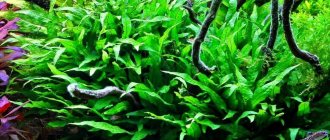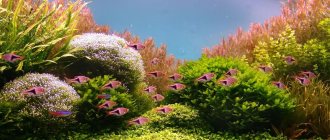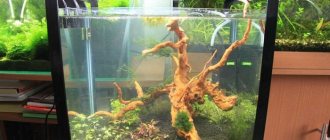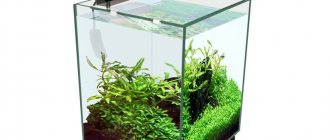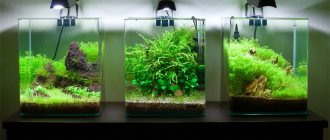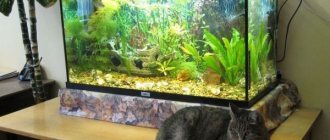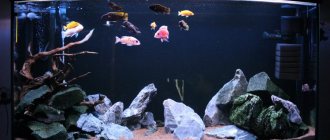Aquarium design is one of the most creative and favorite activities of aquarists, which allows you to show your imagination and create an original and unique tank. In the aquarium hobby, there are many styles for designing artificial reservoirs, and some owners even turn to aquarium designers. However, most aquarists prefer to create an aquarium design with their own hands, receiving enormous pleasure from choosing the decorations. And ideas for interior design and decoration of home aquariums help them in this matter.
Basic aquadesign styles
You can decorate an aquarium with your own hands at home in different styles, according to which you can arrange the water space with taste. It could even be an artificial aquarium. Before choosing one of them for your own artificial pond, you should consider all the options for designing an aquarium of 150 liters and other volumes.
Dutch
Decorating a home aquarium in the Dutch style involves creating a realistic and deep design, to achieve which using vegetation of different shapes and sizes. To make an interior for an aquarium in the Dutch style, you need to adhere to the following rules:
- Living flora is planted in the container: short grasses and algae are placed in front, flowers with large leaves are in the middle, and lush and tall shrubs are behind. This plan allows you to create a feeling of a voluminous natural background.
- Each plant is planted so that it occupies about 10 square meters. see soils. This will make the planting dense, and at the same time the flowers will feel comfortable, growing and forming the natural landscape.
- For Dutch tanks, plants of different colors are selected, combining reddish, green, light green and yellow tones.
- It is better to choose medium-sized fish for such aquariums, painted in bright and catchy colors.
Before you start decorating a tank in the Dutch style, you should take into account that such an aquarium will require constant maintenance:
- Carbon dioxide supply.
- Trimming and feeding vegetation.
- Control of fish numbers.
- Regular cleaning.
Collector's
The collector style of aquarium design is considered a simplified analogue of the Dutch one, and was invented for beginner aquarists. The collection style has captivated aquarists with its lightness and peculiar chaos, thanks to which the space of the home aquarium looks like a natural landscape. Perfect for small aquariums.
So, what does a beginner need for an aquarium if the choice fell on this design style? To create a collection design, plants of different heights and colors are planted in containers, combining them with each other. At the same time, the vegetation is not touched in any way, allowing it to grow as it pleases, which creates an outlandish, slightly neglected garden.
Using Cleaning Products
In cases where heat treatment is impossible for some reason, you can turn to special solutions for help. And although their effectiveness is slightly lower than boiling, they are able to cope with most harmful bacteria.
In order to effectively clean the pebbles, you will need a spacious and durable container. Volume is of great importance, since the solution must completely cover the stones. Each product has its own instructions for use, so for successful cleaning you just need to follow the instructions on the package. After the stones have been in the solution for a day, they will need to be carefully removed and washed thoroughly under running water.
Materials for decoration
Experienced designers can create a unique aquascape from several driftwood and algae, but inexperienced aquarists will need certain things to create a beautiful pond, without which an attractive and complete composition is impossible. This:
- Background – can be represented by a decorative film, a three-dimensional background or painting. The background is installed on the back wall of the tank, increases the space and gives the design a finished look.
- Soil – required for planting vegetation. For novice aquarists, it is better to purchase a ready-made substrate, which just needs to be placed correctly on the bottom.
- Stones – no aquarium design can do without them. You can purchase mock-ups of stones at a pet store, or use natural materials: basalt, quartz or granite.
- Driftwood - used to imitate trunks, roots and mountain slopes, but most often driftwood is placed in aquariums to secure mosses. By fixing the mosses with fishing line, after a while you can get a charming picture: river driftwood in an aquarium, in places covered with a green carpet.
- Vegetation is something without which a home aquarium cannot function. Plants have a positive effect on the health and well-being of fish and help recreate natural conditions.
- Lighting – Proper lighting is considered the key to a beautiful design. By using backlighting, you can highlight good moments and hide flaws and imperfections.
For beginning aquarists, driftwood and algae alone will not be enough to decorate an aquarium in an interesting way.
Heat treatment
At this stage, you will need a regular deep saucepan and running water. It is important that all stones are completely submerged under water. There is no need to add additional additives, as they still won’t do a better job than high temperature. To achieve the greatest effect, it is better to boil water over medium heat for 20-30 minutes.
After this, carefully remove the aquarium stones and leave them to dry on a paper towel. After heating for a long time, they will retain heat for a long time, so they need at least an hour to cool down. After cooling, the stones can be immersed in the aquarium.
Although boiling is a universal remedy, it is not suitable for porous rocks. As the temperature increases, they will begin to crumble and break as soon as the water begins to boil. Therefore, only store-bought products are usually used to disinfect porous rocks.
Decoration stages
Decorating an aquarium is an exciting process, but it is important not to forget about the well-being of the fish, which are the main value of the reservoir. Before creating a composition, you should familiarize yourself with the rules:
- Fish and other living creatures inhabiting an artificial pond are moved to another container for the duration of decoration. This will help avoid accidental injuries that can lead to dire consequences. Once the tank is decorated, the fish and shellfish are returned home.
- New items, decorations, and even plants should be carefully inspected. Decorative elements are processed according to the rules, disinfecting, soaking in water or scalding with boiling water, depending on the structure. Purchased plants and fish are also inspected and quarantined so that the owner is convinced of their safety.
After reading the rules, you should find out what is required to design an artificial reservoir.
Background device
The background is an important part of the design of the tank. A correctly selected background will help to visually expand the pond and complete the overall composition, giving it integrity.
The background can be used:
- Self-adhesive film with a picture.
- Volumetric background made with your own hands from available materials.
- A living background made of plants attached to a grid.
In addition, you can show your imagination and paint the back wall of the tank with paints if the owner is into painting.
Soil selection
The soil helps create an imitation of underwater depths and is a place for planting plants. The choice of substrate is important, since the well-being of the vegetation, and therefore the fish, depends on the type of soil. Beginning aquarists should give preference to ready-made soil sold in pet stores - the substrate already contains nutrients and substances for the growth of flora. But the colors and shades of the primer are selected depending on the requirements of the fish and the chosen style, so that the colors and details are harmoniously combined.
Stones
Decorating an aquarium with stones is a simple option that will create a natural and harmonious look. Specialized stores offer a wide range of artificial pebbles for every taste and color, but dummies cannot compare with natural minerals. When choosing stones, it is important to pay attention to the composition, since some types of stones are dangerous for tank residents. To create a stone garden, choosing quartz, granite and basalt is considered an excellent solution.
Vegetation
Living vegetation in artificial reservoirs saturates the water with oxygen, decorates the tank and serves as a shelter for pets. When choosing types of aquarium flora, novice aquarists should give preference to fast-growing and unpretentious plants that do not require much attention.
Aquarium vegetation is divided into types, among which are floating plants, moss-like plants, drifting on the surface of the water surface and requiring rooting in the ground. Each species is beautiful in its own way, but you should choose greens based on the preferences of the fish and the style of the reservoir.
Lighting
Lighting in the tank is mandatory, as without it the fish will experience stress. However, lighting in a pond can not only imitate sunlight in the wild, but also harmoniously complement the chosen style. By playing with the shades and placement of light bulbs, you can achieve an amazing spectacle that will not leave viewers indifferent.
Seaweed
Aquarium algae is divided into two types: artificial and live. The choice directly depends on the type of fish. There are those that breathe atmospheric air; proximity to artificial algae will not harm them. Among them are labyrinthine betta fish and macropods.
If you plan to keep fish for which the concentration of oxygen in the water is important, it is better to opt for live algae.
Live algae
Cabomba, hornwort, ammania and rotala algae look very impressive in the aquarium. All of them easily take root in natural and artificial soil, do not require special care and turn the aquarium into an underwater forest. By releasing oxygen, they absorb excess carbon dioxide and make the water in the aquarium cleaner.
6 photosPhoto: Instagram _fishkastudio_
Photo: Instagram _studionemo_
Photo: Instagram _studionemo_
Photo: Instagram anna_shaen
Photo: Instagram lazareva_anna21
Photo: Instagram zootovaryperm
Artificial algae
Such algae have their advantages. Clear advantages include cost-effectiveness and durability. They are indispensable in aquariums where fish feed not only on food, but also on plants. In addition, they do not grow and do not need weeding.
Photo: Instagram blackwhite_top
Photo: Instagram n.thomas_photography
Photo: Instagram yliapa
Filling procedure
In aquariums, the design is carried out in stages, in a certain sequence, the observance of which will ensure the correct start-up of the tank and a suitable environment for life. The procedure for decorating artificial reservoirs is as follows:
- Choosing a style or developing an individual style - this could be a river, sea or other theme for decoration.
- Purchasing the necessary elements and objects for decoration.
- Processing jewelry, stones, soil and other purchased items.
- Laying out the soil.
- Placement of decorations and stones, shells for the aquarium.
- Installation of equipment for fish.
- Planting vegetation.
- Filling the tank with settled water, previously tested for suitability for use.
- Settlement of fish and shellfish.
It is not difficult to create a design for a pond with your own hands, but before you begin, you should carefully consider and choose a design style. Not only the appearance of the container itself, but also the entire room as a whole will depend on the correctness of the decision.
General requirements
There is no particular difficulty in coming up with and implementing an aquarium design with your own hands. However, in this matter there are certain principles that should not be deviated from:
- any internal changes are made only in the absence of pets. The fish are moved to a separate small aquarium along with some of the water;
- decor and improvised means are treated by boiling;
- To make sure the stone is safe, a little vinegar is dripped onto it. If foam or hissing appears, such an item cannot be used;
- the parts are secured with cotton thread or fishing line;
- For small fish, fine soil is suitable, and for large fish, combined soil is suitable.
If you comply with the registration requirements, you can be sure that your pets will be safe.
Photos of aquariums with different designs
Driftwood - the center of the composition or elements complementing the overall picture
You can read in detail about driftwood in our article “Driftwood in an aquarium: selection and preparation.” Let us only add that driftwood with moss, which can be secured to it with a thread (it is better to use a dark one), looks very beautiful. The moss will quickly grow and such a thread will not be visible, and over time it will rot, after which your decoration will look as natural and natural as possible, as if this moss actually originally grew on driftwood.
Creation date: 04/12/2017

